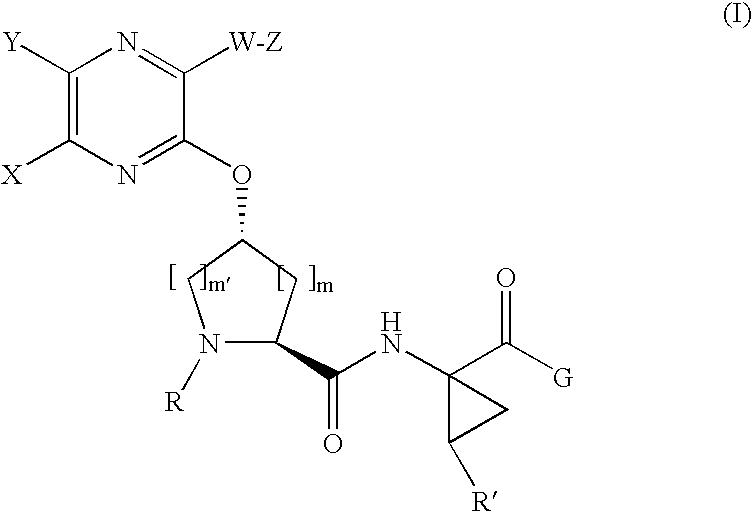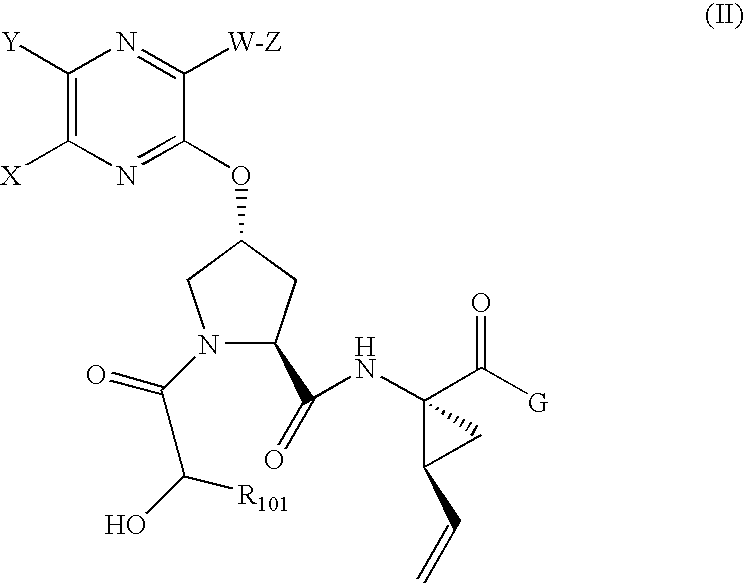Quinoxalinyl dipeptide hepatitis c virus inhibitors
a technology of hepatitis c virus and dipeptide, which is applied in the field of new drugs, can solve the problems of interferon related side effects, inability to reproduce infectious culture systems and small-animal models for hcv, and increasing public health problems
- Summary
- Abstract
- Description
- Claims
- Application Information
AI Technical Summary
Benefits of technology
Problems solved by technology
Method used
Image
Examples
first embodiment
the invention is a compound represented by Formula I as described above, or a pharmaceutically acceptable salt, ester or prodrug thereof, alone or in combination with a pharmaceutically acceptable carrier or excipient.
second embodiment
the invention is a compound represented by Formula II, or a pharmaceutically acceptable salt, ester or prodrug thereof, alone or in combination with a pharmaceutically acceptable carrier or excipient.
Representative subgenera of the invention include, but are not limited to:
A compound of Formula II:
R101 is selected from the group consisting of:(i) aryl; substituted aryl; heteroaryl; substituted heteroaryl;(ii) heterocycloalkyl or substituted heterocycloalkyl;(iii) —C1-C8 alkyl, —C2-C8 alkenyl, or —C2-C8 alkynyl containing 0, 1, 2, or 3 heteroatoms selected from O, S, or N; substituted —C1-C8 alkyl, substituted —C2-C8 alkenyl, or substituted —C2-C8 alkynyl containing 0, 1, 2, or 3 heteroatoms selected from O, S or N; —C3-C12 cycloalkyl, or substituted —C3-C12 cycloalkyl; —C3-C12 cycloalkenyl, or substituted —C3-C12 cycloalkenyl; the representative substitutents include, but are not limited to: hydroxyl, halo, —O—C1-C6 alkyl, —S—C1-C6 alkyl, —SO—C1-C6 alkyl, —SO2—C1-C6 alkyl, —O-aryl o...
example 1
Compound of Formula IV, wherein
To a mixture of Boc cis-L-hydroxyproline methyl ester 1-1 (1.073 g, 4.37 mmol), 3-(thiophen-2-yl)-1H-quinoxalin-2-one 1-2 (0.999 g, 4.38 mmol)) and triphenylphosphine (2.29 g, 8.74 mmol) in THF at 0° C. was added dropwise DIAD (1.72 ml, 8.7 mmol). The resulting mixture was held at 0° C. for 15 min. before being warmed to room temperature. After 18 hours, the mixture was concentrated under vacuum and the residue was purified by chromatography (Hexane / EtOAC=1:0 to 8:2) to give 1-3 (2.28 g).
To a solution of compound 1-3 (2.05 g, 4.5 mmol) in THF / MeOH (20 ml-10 ml) was added aqueous lithium hydroxide (1M, 10 ml, 10 mmol). The mixture was stirred at room temperature for 20 hours. Most organic solvents were evaporated in vacuo, and the resulting residue was diluted with water and acidified to pH 5 to 6. The mixture was extracted with EtOAc three times. The combined organic extracts were dried (MgSO4), filtered and concentrated in vacuo to afford 1-4 (1.76 g)...
PUM
| Property | Measurement | Unit |
|---|---|---|
| temperature | aaaaa | aaaaa |
| pH | aaaaa | aaaaa |
| pH | aaaaa | aaaaa |
Abstract
Description
Claims
Application Information
 Login to View More
Login to View More - R&D
- Intellectual Property
- Life Sciences
- Materials
- Tech Scout
- Unparalleled Data Quality
- Higher Quality Content
- 60% Fewer Hallucinations
Browse by: Latest US Patents, China's latest patents, Technical Efficacy Thesaurus, Application Domain, Technology Topic, Popular Technical Reports.
© 2025 PatSnap. All rights reserved.Legal|Privacy policy|Modern Slavery Act Transparency Statement|Sitemap|About US| Contact US: help@patsnap.com



